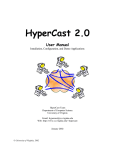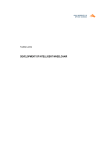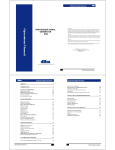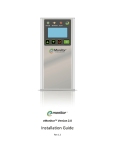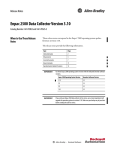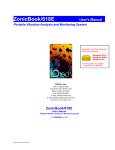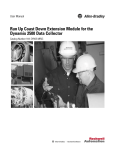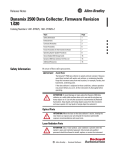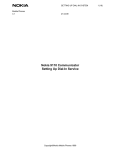Download RSLogix 5000 Programmers Guide for Integrated
Transcript
RSLogix™ 5000
Programmer’s Guide for
Integrated Condition Monitoring
Data Collection
Purpose and Scope
This guide is intended for the programmer or software engineer responsible for programming the
Logix family of controllers (Programmable Automation Controllers - PACs) to get data from any
supported I/O device. This guide contains an explanation of some of the settings needed to move
data from a Logix controller into Emonitor. This guide uses the Allen-Bradley® XM-120 Dynamic
Vibration Module as the example; however a PAC can accept condition monitoring data from other
sources as well.
This guide does not cover using any of the software or other hardware components of an Emonitor
system. For information on using an Emonitor program, refer to the online help for that program.
2 | Emonitor Version 3.5 RSLogix 5000 Interface Guide for XM modules
Introduction
The new Logix family of controllers provides a way to retrieve data from XM modules using
programmable automation controllers (PACs). The PAC reads data from the XM module, and makes
that data available to RSLinx Classic (which functions as an OPC server). The Emonitor software
imports the data from RSLinx Classic into the Emonitor database, where it can be analyzed in
Emonitor.
This guide is divided into several sections. The first section defines the UDTs required to get data
from an XM module using a PAC. The remaining sections describe the handshaking routine to protect
data integrity, the sample project file, and the details of reading data from XM modules.
Terms used in this guide
Emonitor Program: Refers to the software programs in the Emonitor family, such as those in the
Emonitor Workstation, Emonitor Factory, and Emonitor Enterprise. Emonitor includes a database for
storing condition monitoring data and powerful tools for alarming, reporting, and data analysis.
PAC: A programmable automation controller; specifically one of the Logix family of controllers.
UDT: User defined data type; a data structure that lets you create customized memory records that
consolidate multiple fields (members) of data into a single contiguous group with a hierarchical layout.
ICM: Integrated Condition Monitoring, which includes capturing, analyzing and effectively using
machine condition information to reduce maintenance costs and increase uptime and productivity.
Emonitor Online Data Management Console: An Emonitor software component that starts and
stops data acquisition through the XM/DYN Online Data and Logix Online Data data sources.
Logix Online Data data source: An Emonitor software component that gets data from a Logix PAC.
3 | Emonitor Version 3.5 RSLogix 5000 Interface Guide for XM modules
Sample project file
There is a sample project file that shows how the information in this guide can be used in an RSLogix
5000 project. The project is located on the Emonitor version 3.50 software installation disk:
\extras\RSLogix Application\ICM DATA APP.ACD
RSLogix 5000 programming manuals
For more information on the topics covered in this guide, refer to the RSLogix 5000 Programming
manuals, found on the Rockwell Literature Library, http://www.rockwellautomation.com/literature/.
Publication Title
Publication Number
Logix5000 Controllers Add-on Instructions Programming Manual
1756-PM010C-EN-P
Logix5000 Controllers ASCII Strings Programming Manual
1756-PM013B-EN-P
Logix5000 Controllers Common Procedures Programming Manual
1756-PM001M-EN-E
Logix5000 Controllers Controller Information and Status Programming
Manual
1756-PM015C-EN-P
Logix5000 Controllers Function Block Diagram Programming Manual
1756-PM009C-EN-P
Logix5000 Controllers I/O and Tag Data Programming Manual
1756-PM004C-EN-P
Logix5000 Controllers IEC 61131-3 Compliance Programming Manual
1756-PM018B-EN-P
Logix5000 Controllers Ladder Diagram Programming Manual
1756-PM008C-EN-P
Logix5000 Controllers Major, Minor, and I/O Faults Programming Manual
1756-PM014D-EN-P
Logix5000 Controllers Messages Programming Manual
1756-PM012C-EN-P
Logix5000 Controllers Nonvolatile Memory Programming Manual
1756-PM017D-EN-P
Logix5000 Controllers Produced and Consumed Tags Programming Manual
1756-PM011C-EN-P
4 | Emonitor Version 3.5 RSLogix 5000 Interface Guide for XM modules
Overview of ICM data types in RSLogix 5000
In the integrated condition monitoring world, each piece of data that is collected contains numerous
elements. Some of the elements are time stamps, data units, signal detection, actual values and
more. To ensure data integrity, each element of the data must be read before any updates in the
controller.
ICM data types
Based on the data structure and the need for data integrity, it is necessary to create user defined data
types to hold the different types of data. There are seven different data types that are used in
integrated condition monitoring.
Data Type
Description
UDT
Values
This data is normal single value data that can be
numeric, magnitude, or enumerated (Emonitor
data types)
ICM_Data_Value
Vectors
This data is considered single value data that
contains a magnitude and phase. It can only be of
type magnitude (Emonitor data type).
ICM_Data_Vector
Spectrum –
Normalized
This data is considered multi-value data and it
contains the spectrum data in a normalized form.
The normalized form indicates that there is a denormalizing factor and a set of normalized integer
values.
ICM_Data_Spectrum_Normalized
Spectrum –
Actual
This data is considered multi-value data and it
contains the spectrum data in a de-normalized
form. Instead of a de-normalizing factor and a set
of normalized integers, there is a set of real
values.
ICM_Data_Spectrum_Actual
Time
Waveforms –
Normalized
This data is considered multi-value data and it
contains the time waveform data in a normalized
form. The normalized form indicates that there is a
de-normalizing factor and a set of normalized
integer values.
ICM_Data_TimeWaveform_Normalized
Time
Waveforms Actual
This data is considered multi-value data and it
contains the time waveform data in a denormalized form. Instead of a de-normalizing
factor and a set of normalized integers, there is a
set of real values.
ICM_Data_ TimeWaveform _Actual
Date and Time
Stamp
This data consists of the date and time information
in UTC time. It is used in each of the data types
listed in this table as a nested UDT
ICM_WallClockType
5 | Emonitor Version 3.5 RSLogix 5000 Interface Guide for XM modules
The names of the user defined types must match the information in the table above. If you need to
define multiple UDTs for each data type, a suffix can be attached to the names. Multiple UDTs would
be required if you want different sizes of arrays for more efficient memory allocation.
Also there must be two user defined string types created:
Data
Type
Description
String_16
This string is a 16 character string. In the ICM data UDT elements, this is used as the data type
for the units. Emonitor can have unit names of up to 16 characters.
String_32
This string is a 32 character string. In the ICM data UDT elements, this is used as the data type
for the Item Name. Emonitor can have item names of up to 32 characters.
ICM_Data_Value UDT
The ICM_Data_Value user defined type consists of the following elements:
Name
NumberOfDataValues
ItemName
Data Type
DINT
String_32[ xx ]
Style
Decimal
Units
DataValueType
String_16[ xx ]
SINT[ xx ]
Controller_UTC_DateTime
ICM_WallClockTime
Device_UTC_DateTime
ICM_WallClockTime
RTR
OTR
SignalDetection
BOOL
BOOL
SINT[ xx ]
Decimal
Decimal
Decimal
DataValues
REAL[ xx ]
Float
Decimal
Description
NUMBER OF VALUES PRESENT IN DATA ARRAY
EMONITOR DATA TAG NAME FOR THIS DATA
ITEM
DATA VALUE UNITS
0=NONE, 1=MAGNITUDE, 2=NUMERIC,
3=ENUMERATED.
CONTROLLER’S DATE/TIME IN UTC AT THE TIME
OF DATA COLLECTION
DEVICE’S DATE/TIME IN UTC AT THE TIME OF
DATA COLLECTION
REQUEST TO READ HANDSHAKE BIT
OK TO READ HANDSHAKE BIT
0=NONE, 1=RMS, 2=CALCULATED PK,
3=CALCULATED PK-PK, 4=TRUE PK, 5=TRUE PKPK
DATA ITEM VALUE
External Access
Read/Write
Read/Write
Read/Write
Read/Write
Read/Write
Read/Write
Read/Write
Read/Write
Read/Write
Read/Write
A deviation to this UDT can be the following as indicated by the bold text in the Data Type column of
the last row. This replaces the REAL array with DINT array.
DataValues
DINT[ xx ]
Float
DATA ITEM VALUE
Read/Write
In the table above the “[ xx ]” will be replaced with the actual array size. Array sizes in Logix are static,
meaning that memory is allocated, whether it is actually used or not.
6 | Emonitor Version 3.5 RSLogix 5000 Interface Guide for XM modules
ICM_Data_Vector UDT
The ICM_Data_Vector user defined type consists of the following elements:
Name
Data Type
Style
NumberOfDataValues
DINT
Decimal
ItemName
MagnitudeUnits
String_32[ xx ]
String_16[ xx ]
PhaseUnits
DataValueType
BOOL[32]
SINT[ xx ]
Controller_UTC_DateTime
ICM_WallClockTime
Device_UTC_DateTime
RTR
OTR
ICM_WallClockTime
BOOL
BOOL
Decimal
Decimal
SignalDetection
MagnitudeValues
PhaseValues
SINT[ xx ]
REAL[ xx ]
REAL[ xx ]
Decimal
Float
Float
Decimal
Decimal
Description
NUMBER OF DATA VALUES PRESENT IN DATA
ARRAY
EMONITOR DATA TAG NAME FOR THIS DATA
ITEM
DATA VALUE MAGNITUDE UNITS
DATA VALUE PHASE UNITS (0=DEGREES, 1=
RADIANS) FOR DATA ALIGN ON RSLOGIX5000,
BOOL ARRAY SIZE MAY BE GREATER THAN
NUMBEROFDATAVALUES. (IF
NUMBEROFDATAVALUES IS 50, BOOL ARRAY
SIZE MUST BE 64 ON RSLOGIX5000.)
ONLY CAN BE 1=MAGNITUDE
CONTROLLER’S DATE/TIME IN UTC AT THE TIME
OF DATA COLLECTION
DEVICE’S DATE/TIME IN UTC AT THE TIME OF
DATA COLLECTION
REQUEST TO READ HANDSHAKE BIT
OK TO READ HANDSHAKE BIT
0=NONE, 1=RMS, 2=CALCULATED PK,
3=CALCULATED PK-PK, 4=TRUE PK, 5=TRUE PKPK
MAGNITUDE DATA VALUES
PHASE DATA VALUES
External Access
Read/Write
Read/Write
Read/Write
Read/Write
Read/Write
Read/Write
Read/Write
Read/Write
Read/Write
Read/Write
Read/Write
Read/Write
In the table above the “[ xx ]” will be replaced with the actual array size. Array sizes in Logix are static,
meaning that memory is allocated, whether it is actually used or not.
7 | Emonitor Version 3.5 RSLogix 5000 Interface Guide for XM modules
ICM_Data_Spectrum_Normalized
The ICM_Data_Spectrum_Normalized user defined type consists of the following elements:
Name
ItemName
Data Type
String_32
Style
AmplitudeUnits
Controller_UTC_DateTime
String_16
ICM_WallClockTime
Device_UTC_DateTime
ICM_WallClockTime
RTR
OTR
SpeedUnits
OrdersFlag
BOOL
BOOL
BOOL
BOOL
Decimal
Decimal
Decimal
Decimal
CPBFlag
PowerFlag
BOOL
BOOL
Decimal
Decimal
ComplexFlag
BOOL
Decimal
SignalDetection
SINT
Decimal
WindowType
DINT
Decimal
WindowLineshapeFactor
AverageTypeEnumeration
REAL
DINT
Float
Decimal
Speed
REAL
Float
NumberOfLines
Fmax
DINT
REAL
Decimal
Float
Fmin
REAL
Float
AmplitudeReference
NormalizingConversionFactor
DataValues
REAL
DINT
INT[ xxxx ]
Float
Decimal
Decimal
Description
EMONITOR DATA TAG NAME FOR THIS
SPECTRUM
SPECTRUM AMPLITUDE UNITS
CONTROLLER’S DATE/TIME IN UTC AT THE TIME
OF SPECTRUM COLLECTION
DEVICE’S DATE/TIME IN UTC AT THE TIME OF
SPECTRUM COLLECTION
REQUEST TO READ HANDSHAKE BIT
OK TO READ HANDSHAKE BIT
SPEED FEEDBACK UNITS (0=HZ, 1=CPM)
FREQUENCY UNITS AS HERTZ OR ORDERS
(1=ORDERS, 0=HZ)
CPB OR NONE (1=CPB, 0=NONE)
NORMALIZED SPECTRUM DATA FORMAT
(1=POWER, 0=NONE)
NORMALIZED SPECTRUM DATA
(1=COMPLEX,0=REAL/POWER)
0=NONE, 1=RMS, 2=CALCULATED PK,
3=CALCULATED PK-PK,4=TRUE PK, 5=TRUE PKPK
WINDOWTYPE: (1=RECTANGULAR,
2=HANNING, 3=FLAT TOP, 4=HAMMING,
5=KAISER-BESSEL, 6=COS).
WINDOW LINE TYPE FACTOR
AVERAGETYPEENUMERATION: (0 = USED IN XM
ONLINE DATA, 1=LINEAR, 2=TIME
SYNCHRONOUS, 3=EXPONENTIAL, 4=PEAK
HOLD).
SPEED FEEDBACK AT TIME OF SPECTRUM
COLLECTION
NUMBER OF SPECTRUM LINES
MAXIMUM FREQUENCY OR ORDERS OF
SPECTRUM DATA.
MINIMUM FREQUENCY OR ORDERS OF
SPECTRUM DATA
AMPLITUDE NORMALIZATION REFERENCE
AMPLITUDE CONVERSION FACTOR
NORMALIZED SPECTRUM DATA, IF
COMPLEXFLAG IS 1, ARRAYSIZE = 2 *
NUMBEROFLINES, IF COMPLEXFLAG IS 0,
ARRAYSIZE = NUMBEROFLINES.
External Access
Read/Write
Read/Write
Read/Write
Read/Write
Read/Write
Read/Write
Read/Write
Read/Write
Read/Write
Read/Write
Read/Write
Read/Write
Read/Write
Read/Write
Read/Write
Read/Write
Read/Write
Read/Write
Read/Write
Read/Write
Read/Write
Read/Write
In the table above the “[ xxxx ]” will be replaced with the actual array size that will hold either the
quantity of lines or two times the number of lines. Array sizes in Logix are static, meaning that
memory is allocated, whether it is actually used or not.
8 | Emonitor Version 3.5 RSLogix 5000 Interface Guide for XM modules
ICM_Data_Spectrum_Actual
The ICM_Data_Spectrum_Actual user defined type consists of the following elements:
Name
Data Type
Style
ItemName
AmplitudeUnits
String_32
String_16
Controller_UTC_DateTime
ICM_WallClockTime
Device_UTC_DateTime
RTR
OTR
SpeedUnits
ICM_WallClockTime
BOOL
BOOL
BOOL
Decimal
Decimal
Decimal
OrdersFlag
CPBFlag
BOOL
BOOL
Decimal
Decimal
PowerFlag
BOOL
Decimal
ComplexFlag
BOOL
Decimal
SignalDetection
SINT
Decimal
WindowType
WindowLineshapeFactor
DINT
REAL
Decimal
Float
AverageTypeEnumeration
DINT
Decimal
Speed
NumberOfLines
REAL
DINT
Float
Decimal
Fmax
REAL
Float
Fmin
REAL
Float
DataValues
REAL[ xxxx ]
Decimal
Description
EMONITOR DATA TAG NAME FOR THIS
SPECTRUM
SPECTRUM AMPLITUDE UNITS
CONTROLLER’S DATE/TIME IN UTC AT THE TIME
OF SPECTRUM COLLECTION
DEVICE’S DATE/TIME IN UTC AT THE TIME OF
SPECTRUM COLLECTION
REQUEST TO READ HANDSHAKE BIT
OK TO READ HANDSHAKE BIT
SPEED FEEDBACK UNITS (0=HZ, 1=CPM)
FREQUENCY UNITS AS HERTZ OR ORDERS
(1=ORDERS, 0=HZ)
CPB OR NONE (1=CPB, 0=NONE)
ACTUAL SPECTRUM DATA FORMAT (1=POWER,
0=NONE)
ACTUAL SPECTRUM DATA
(1=COMPLEX,0=REAL/POWER)
0=NONE, 1=RMS, 2=CALCULATED PK,
3=CALCULATED PK-PK,4=TRUE PK, 5=TRUE PKPK
WINDOWTYPE: (1=RECTANGULAR,
2=HANNING, 3=FLAT TOP, 4=HAMMING,
5=KAISER-BESSEL, 6=COS).
WINDOW LINE TYPE FACTOR
AVERAGETYPEENUMERATION: (0 = USED IN XM
ONLINE DATA, 1=LINEAR, 2=TIME
SYNCHRONOUS, 3=EXPONENTIAL, 4=PEAK
HOLD).
SPEED FEEDBACK AT TIME OF SPECTRUM
COLLECTION
NUMBER OF SPECTRUM LINES
MAXIMUM FREQUENCY OR ORDERS OF
SPECTRUM DATA.
MINIMUM FREQUENCY OR ORDERS OF
SPECTRUM DATA
ACTUAL SPECTRUM DATA, IF COMPLEXFLAG IS
1, ARRAYSIZE = 2 * NUMBEROFLINES, IF
COMPLEXFLAG IS 0, ARRAYSIZE =
NUMBEROFLINES.
External Access
Read/Write
Read/Write
Read/Write
Read/Write
Read/Write
Read/Write
Read/Write
Read/Write
Read/Write
Read/Write
Read/Write
Read/Write
Read/Write
Read/Write
Read/Write
Read/Write
Read/Write
Read/Write
Read/Write
Read/Write
In the table above the “[ xxxx ]” will be replaced with the actual array size that will hold either the
quantity of lines or two times the number of lines. Array sizes in Logix are static, meaning that
memory is allocated, whether it is actually used or not.
9 | Emonitor Version 3.5 RSLogix 5000 Interface Guide for XM modules
ICM_Data_TimeWaveform_Normalized
The ICM_Data_TimeWaveform_Normalized user defined type consists of the following elements:
Name
Data Type
Style
ItemName
AmplitudeUnits
String_32
String_16
Controller_UTC_DateTime
ICM_WallClockTime
Device_UTC_DateTime
RTR
OTR
SpeedUnits
PeriodFlag
SamplingMode
ICM_WallClockTime
BOOL
BOOL
BOOL
BOOL
BOOL
Decimal
Decimal
Decimal
Decimal
Decimal
AverageTypeEnumeration
DINT
Decimal
Speed
NumberOfPoints
Period
AmplitudeReference
NormalizingConversionFactor
DataValues
REAL
DINT
REAL
REAL
DINT
INT[xxxx ]
Float
Decimal
Float
Float
Decimal
Decimal
Description
EMONITOR DATA TAG NAME FOR THIS TIME
WAVEFORM
WAVEFORM AMPLITUDE UNITS
CONTROLLER’S DATE/TIME IN UTC AT THE TIME
OF WAVEFORM COLLECTION
DEVICE’S DATE/TIME IN UTC AT THE TIME OF
WAVEFORM COLLECTION
REQUEST TO READ HANDSHAKE BIT
OK TO READ HANDSHAKE BIT
SPEED FEEDBACK UNITS (0=HZ, 1=CPM)
0=SECONDS, 1=CYCLES
0=ASYNCHRONOUS, 1=SYNCHRONOUS
AVERAGETYPEENUMERATION: (0 = USED IN XM
ONLINE DATA, 1=LINEAR, 2=TIME
SYNCHRONOUS, 3=EXPONENTIAL, 4=PEAK
HOLD).
SPEED FEEDBACK AT TIME OF WAVEFORM
COLLECTION
NUMBER OF TIME WAVEFORM DATA POINTS
TIME WAVEFORM PERIOD
AMPLITUDE NORMALIZATION REFERENCE
AMPLITUDE CONVERSION FACTOR
NORMALIZED TIME WAVEFORM DATA
External Access
Read/Write
Read/Write
Read/Write
Read/Write
Read/Write
Read/Write
Read/Write
Read/Write
Read/Write
Read/Write
Read/Write
Read/Write
Read/Write
Read/Write
Read/Write
Read/Write
In the table above the “[ xxxx ]” will be replaced with the actual array size that will hold either the
quantity of points in the waveform. Array sizes in Logix are static, meaning that memory is allocated,
whether it is actually used or not.
10 | Emonitor Version 3.5 RSLogix 5000 Interface Guide for XM modules
ICM_Data_TimeWaveform_Actual
The ICM_Data_TimeWaveform_Actual user defined type consists of the following elements:
Name
Data Type
Style
ItemName
AmplitudeUnits
String_32
String_16
Controller_UTC_DateTime
ICM_WallClockTime
Device_UTC_DateTime
RTR
OTR
SpeedUnits
PeriodFlag
SamplingMode
ICM_WallClockTime
BOOL
BOOL
BOOL
BOOL
BOOL
Decimal
Decimal
Decimal
Decimal
Decimal
AverageTypeEnumeration
DINT
Decimal
Speed
NumberOfPoints
Period
DataValues
REAL
DINT
REAL
REAL[ xxxx ]
Float
Decimal
Float
Float
Description
EMONITOR DATA TAG NAME FOR THIS TIME
WAVEFORM
WAVEFORM AMPLITUDE UNITS
CONTROLLER’S DATE/TIME IN UTC AT THE TIME
OF WAVEFORM COLLECTION
DEVICE’S DATE/TIME IN UTC AT THE TIME OF
WAVEFORM COLLECTION
REQUEST TO READ HANDSHAKE BIT
OK TO READ HANDSHAKE BIT
SPEED FEEDBACK UNITS (0=HZ, 1=CPM)
(0=SECONDS 1=CYCLES)
(0=ASYNCHRONOUS, 1=SYNCHRONOUS)
AVERAGETYPEENUMERATION: (0 = USED IN XM
ONLINE DATA, 1=LINEAR, 2=TIME
SYNCHRONOUS, 3=EXPONENTIAL, 4=PEAK
HOLD).
SPEED FEEDBACK AT TIME OF WAVEFORM
COLLECTION
NUMBER OF TIME WAVEFORM DATA POINTS
TIME WAVEFORM PERIOD
WAVEFORM DATA ACTUAL VALUES
External Access
Read/Write
Read/Write
Read/Write
Read/Write
Read/Write
Read/Write
Read/Write
Read/Write
Read/Write
Read/Write
Read/Write
Read/Write
Read/Write
Read/Write
In the table above the “[ xxxx ]” will be replaced with the actual array size that will hold either the
quantity of points in the waveform. Array sizes in Logix are static, meaning that memory is allocated,
whether it is actually used or not.
ICM_WallClockTime
The ICM_WallClockTime user defined type consists of the following elements:
Name
Year
Month
Day
Hour
Minute
Second
Microseconds
Data Type
DINT
DINT
DINT
DINT
DINT
DINT
DINT
Style
Decimal
Decimal
Decimal
Decimal
Decimal
Decimal
Decimal
Description
YEAR (FOUR DIGIT NUMBER)
MONTH (1-12)
DAY (1-31)
HOUR (0-23)
MINUTE (0-59)
SECOND (0-59)
MICROSECONDS (0-999,999)
External Access
Read/Write
Read/Write
Read/Write
Read/Write
Read/Write
Read/Write
Read/Write
11 | Emonitor Version 3.5 RSLogix 5000 Interface Guide for XM modules
Handshaking mechanism and ICM data values
ICM handshaking mechanism
Since the data contains multiple elements, there needs to be a mechanism in place to ensure that the
data does not change as it is being read from the controller. This is the purpose of the handshaking
elements (RTR and OTR) in the user defined types.
There is also a need to time out the hand shaking if there is a communication loss. By default the time
out should be twenty (20) seconds. This is the default on the Emonitor side.
The normal handshake process between Emonitor and Logix for scheduled data collection is as
follows:
1. Emonitor (or other application) sets the ready to read (RTR) flag.
2. The Logix application then verifies that data is not being writte, or finishes writing to the data
points.
3. Logix sets the ok to read (OTR) flag.
4. Emonitor reads the data.
5. When Emonitor is done reading the data, it clears the ready to read (RTR) flag.
6. When Logix sees the ready to read (RTR) flag cleared, it clears the ok to read (OTR) flag.
7. Once the ok to read (OTR) flag is cleared, Logix can update data.
The normal handshake process between Emonitor and Logix for triggered data collection is as
follows:
1. Logix sets the trigger.
2. When trigger is true, Emonitor (or other application) sets the ready to read (RTR) flag.
3. Logix application then verifies that data is not being writte, or finishes writing to the data
points.
4. Logix sets the ok to read (OTR) flag.
5. Emonitor reads the data.
6. When Emonitor is done reading the data, it clears the ready to read (RTR) flag
7. When Logix sees the ready to read (RTR) flag cleared, it clears the ok to read (OTR) flag.
8. Once the ok to read (OTR) flag is cleared, Logix can reset the trigger if necessary and update
the data.
Timeout functionality:
1. If the RTR flag is set true, and in twenty seconds, Emonitor does not see the OTR flag, the
RTR and OTR flags are cleared.
2. If the RTR flag is set true, and in twenty seconds, Logix does not see the OTR flag, the RTR
and OTR flags are cleared.
12 | Emonitor Version 3.5 RSLogix 5000 Interface Guide for XM modules
Each tag defined as an ICM data type must have a handshake set up for it. In the sample ACD file,
there is an Add On Instruction (AOI) that is defined for this purpose. The add-on instruction functions
as described above, but has an added mechanism to handle the asynchronous multi-tasking
environment on the Logix side.
Hand Shaking AOI - ICM_Handshaking
The name of the instruction is ICM_Handshaking. The parameters for the instruction are defined as:
Name
Usage
Data Type
Description
EnableIn
Input
BOOL
Enable Input - System Defined Parameter
EnableOut
Output
BOOL
Enable Output - System Defined Parameter
BlockDataUpdates
Output
BOOL
FLAG TO BLOCK THE DATA UPDATES FOR THE DATA
THAT IS TO BE READ
DataUpdatesBlocked
Input
BOOL
FLAG THAT THE DATA UPDATE HAS BEEN BLOCKED.
TimedOut
Output
BOOL
FLAG TO INDICATE THAT THE HANDSHAKE TIMED OUT.
TimeoutTime
Input
DINT
TIME OUT PRESET (DEFAULTS TO 20 SECONDS (20000
ms) IF NOT CHANGED)
ReadyToRead
InOut
BOOL
READY TO READ FLAG FROM DEVICE THAT IS TO READ
THE DATA
OkToRead
InOut
BOOL
OK TO READ DATA FROM THIS CONTROLLER SENT TO
THE DEVICE THAT IS TO READ THE DATA
When using the instruction, there will be a backing tag created for it. This backing tag will be created
as data type “ICM_Handshaking” which is the same name as the instruction.
The elements of the backing tag will consist of the parameters that are either input or output but not
the InOut type.
Name
Usage
Data Type
Description
EnableIn
Input
BOOL
Enable Input - System Defined Parameter
EnableOut
Output
BOOL
Enable Output - System Defined Parameter
BlockDataUpdates
Output
BOOL
FLAG TO BLOCK THE DATA UPDATES FOR THE
DATA THAT IS TO BE READ
DataUpdatesBlocked
Input
BOOL
FLAG THAT THE DATA UPDATE HAS BEEN BLOCKED.
TimedOut
Output
BOOL
FLAG TO INDICATE THAT THE HANDSHAKE TIMED
OUT.
TimeoutTime
Input
DINT
TIME OUT PRESET (DEFAULTS TO 20 SECONDS
(20000 ms) IF NOT CHANGED)
13 | Emonitor Version 3.5 RSLogix 5000 Interface Guide for XM modules
The purpose of the handshaking instruction is to isolate the code and functionality so the programmer
does not have to repeat all of it for each tag.
A structured text call to the instruction looks like the following:
ICM_Handshaking(handShaking[ index1 ], icmNode_01_XM120_Spectrum[ index1 ].RTR,
icmNode_01_XM120_Spectrum[ index1 ].OTR );
Where
•
handshaking[ index1 ] is an indexed array element of the type ICM_Handshaking
•
icmNode_01_XM120_Spectrum[ index1 ] is an indexed array element of the type
ICM_Data_Sprectrum_Normalized.
When the instruction is executed, the following happens:
•
•
If the ready to read parameter transitions from true to false,
o
The ok to read parameter is cleared
o
BlockDataUpdates parameter is cleared
o
The DataUpdatesBlocked parameter is cleared
If the ready to read parameter is false ( no transition )
o
•
Nothing happens
If the ready to read parameter is true
o
Enable the time out timer
o
If the time out timer is not done timing
o
If the BlockDataUpdates parameter is false then set the BlockDataUpdates
parameter
If the BlockDataUpdates parameter is true and the DataUpdatesBlocked
parameter is true, set the ok to read parameter.
If the time out timer is done timing
Clear the ready to read parameter
Clear the ok to read parameter
Clear the BlockDataUpdates parameter
Clear the DataUpdatesBlocked parameter
Set the time out parameter
Reset the time out timer.
The BlockDataUpdates parameter allows for the programmer to place the handshake call in any task
and handle the asynchronous behavior of multi-tasking environment. So when the BlockDataUpdates
parameter is set, the user routine finishes updating the data and/or makes sure that the data is not
updated again, and then sets the DataUpdatesBlocked parameter. See the sample Logix project file
for details.
14 | Emonitor Version 3.5 RSLogix 5000 Interface Guide for XM modules
ICM data values
Data in the ICM_Data_Values
The ICM_Data_Value user defined type consists of the following elements:
Name
NumberOfDataValues
ItemName
Data Type
DINT
String_32[ xx ]
Style
Decimal
Units
DataValueType
String_16[ xx ]
SINT[ xx ]
Controller_UTC_DateTime
ICM_WallClockTime
Device_UTC_DateTime
ICM_WallClockTime
RTR
OTR
SignalDetection
BOOL
BOOL
SINT[ xx ]
Decimal
Decimal
Decimal
DataValues
REAL[ xx ]
Float
Decimal
Description
NUMBER OF VALUES PRESENT IN DATA ARRAY
EMONITOR DATA TAG NAME FOR THIS DATA
ITEM
DATA VALUE UNITS
0=NONE, 1=MAGNITUDE, 2=NUMERIC,
3=ENUMERATED.
CONTROLLER’S DATE/TIME IN UTC AT THE TIME
OF DATA COLLECTION
DEVICE’S DATE/TIME IN UTC AT THE TIME OF
DATA COLLECTION
REQUEST TO READ HANDSHAKE BIT
OK TO READ HANDSHAKE BIT
0=NONE, 1=RMS, 2=CALCULATED PK,
3=CALCULATED PK-PK, 4=TRUE PK, 5=TRUE PKPK
DATA ITEM VALUE
External Access
Read/Write
Read/Write
Read/Write
Read/Write
Read/Write
Read/Write
Read/Write
Read/Write
Read/Write
Read/Write
The ICM_Data_Value user defined type consists of the following elements:
•
The value of the xx in the elements that are arrays must be greater than or equal to the
number of data values to use.
•
When a tag of type ICM_Data_Value is to be used to collect data, certain elements must be
initialized, and some are optional.
NumberOfDataValues
The initialization of the NumberOfDataValues is required. When attached to an Emonitor Online
System, the number of data values to use controls what the engineer can map. If not initialized,
defaults to zero in the controller. Emonitor Online System does not display items associated with this
tag unless it contains a value greater than zero.
ItemName
The initialization of the ItemName array elements is optional. When used, the item name array
elements can help identify the data. When attached to an Emonitor online system and item name
array elements contain values, Emonitor uses the item name to create measurement definitions
during auto-mapping.
Units
The initialization of the Units array elements is required. When attached to an Emonitor Online
System, Emonitor uses the units in the mapping rules.
DataValueType
The initialization of the DataValueType array elements is required. When attached to an Emonitor
Online System, the data value types are used in the mapping rules. During runtime, the data value
type is used to determine the value to store in the database based on signal detection settings.
15 | Emonitor Version 3.5 RSLogix 5000 Interface Guide for XM modules
Controller_UTC_DateTime
The initialization of the Controller_UTC_DateTime elements is not required. During runtime the
elements of this field must be updated. This structure contains the time (UTC) that the data was
collected on the controller side. Use the GSV command for WallClockTime to get the elements from
the controller.
Device_UTC_DateTime
The initialization of the Device_UTC_DateTime elements is not required. During runtime the elements
of this field are updated, depending on the device that is collecting the data. This structure contains
the time (UTC) that the data was collected on the device side.
RTR (Ready to Read)
The initialization of the RTR (Ready to Read) element is not required. When attached to an Emonitor
Online System, the ready to read element is written to by the Logix Online Data driver. It is only
written to by the controller when there is a time-out in the handshaking mechanism.
OTR (Ok to Read)
The initialization of the OTR (Ok to Read) element is not required. When attached to an Emonitor
Online System, the ok to read element is written to by the controller during the handshaking to ensure
data is being written to while it is being read.
SignalDetection
The initialization of the SignalDetection array elements is required. When attached to an Emonitor
Online System, the data is stored in the database as RMS. Signal Detection setting and data type will
determine how the value is transformed into an RMS value. Signal Detection is used for data type
magnitude only, being ignored when the data type is numeric or enumerated.
DataValues
The initialization of the DataValues element is not required. During runtime, the data collected from
the device must be placed into this array.
16 | Emonitor Version 3.5 RSLogix 5000 Interface Guide for XM modules
Data in the ICM_Data_Vectors
The ICM_Data_Vector user defined type consists of the following elements:
Name
Data Type
Style
NumberOfDataValues
DINT
Decimal
ItemName
MagnitudeUnits
String_32[ xx ]
String_16[ xx ]
PhaseUnits
DataValueType
BOOL[32]
SINT[ xx ]
Controller_UTC_DateTime
ICM_WallClockTime
Device_UTC_DateTime
RTR
OTR
ICM_WallClockTime
BOOL
BOOL
Decimal
Decimal
SignalDetection
MagnitudeValues
PhaseValues
SINT[ xx ]
REAL[ xx ]
REAL[ xx ]
Decimal
Float
Float
Decimal
Decimal
Description
NUMBER OF DATA VALUES PRESENT
IN DATA ARRAY
EMONITOR DATA TAG NAME FOR
THIS DATA ITEM
DATA VALUE MAGNITUDE UNITS
DATA VALUE PHASE UNITS
(0=DEGREES, 1= RADIANS) FOR
DATA ALIGN ON RSLOGIX5000,
BOOL ARRAY SIZE MAY BE GREATER
THAN NUMBEROFDATAVALUES. (IF
NUMBEROFDATAVALUES IS 50,
BOOL ARRAY SIZE MUST BE 64 ON
RSLOGIX5000.)
ONLY CAN BE 1=MAGNITUDE
CONTROLLER’S DATE/TIME IN UTC
AT THE TIME OF DATA COLLECTION
DEVICE’S DATE/TIME IN UTC AT THE
TIME OF DATA COLLECTION
REQUEST TO READ HANDSHAKE BIT
OK TO READ HANDSHAKE BIT
0=NONE, 1=RMS, 2=CALCULATED
PK, 3=CALCULATED PK-PK, 4=TRUE
PK, 5=TRUE PK-PK
MAGNITUDE DATA VALUES
PHASE DATA VALUES
External
Access
Read/Write
Read/Write
Read/Write
Read/Write
Read/Write
Read/Write
Read/Write
Read/Write
Read/Write
Read/Write
Read/Write
Read/Write
•
The value of the xx in the elements that are arrays must be greater than or equal to the
number of data values to use.
•
When a tag of type ICM_Data_Vector is to be used to collect data, certain elements must be
initialized, and some are optional.
NumberOfDataValues
The initialization of the NumberOfDataValues is required. When attached to an Emonitor Online
System, the number of data values to use controls what the engineer can map. If not initialized,
defaults to zero in the controller. Emonitor Online System does not display items associated with this
tag unless it contains a value greater than zero.
ItemName
The initialization of the ItemName array elements is optional. When used, the item name array
elements can help identify the data. When attached to an Emonitor online system and item name
array elements contain values, Emonitor uses the item name to create measurement definitions
during auto-mapping.
17 | Emonitor Version 3.5 RSLogix 5000 Interface Guide for XM modules
MagnitudeUnits
The initialization of the MagnitudeUnits array elements is required. When attached to an Emonitor
Online System, the units are used in the mapping rules.
PhaseUnits
The initialization of the PhaseUnits array elements is required. When attached to an Emonitor Online
System, the phase data is stored in the Emonitor database in units of radians. Devices may give the
phase in degrees or radians.
DataValueType
The initialization of the DataValueType array elements is required. For the vector data, the data value
type must be magnitude.
SignalDetection
The initialization of the SignalDetection array elements is required. When attached to an Emonitor
Online System, the data is stored in the database as RMS. Signal Detection setting will determine
how the value is transformed into an RMS value.
Controller_UTC_DateTime
The initialization of the Controller_UTC_DateTime elements is not required. During runtime the
elements of this field must be updated. This structure contains the time (UTC) that the data was
collected on the controller side.
Use the GSV command for WallClockTime to get the elements from the controller.
Device_UTC_DateTime
The initialization of the Device_UTC_DateTime elements is not required. During runtime the elements
of this field will be updated, depending on the device that is collecting the data. This structure
contains the time (UTC) that the data was collected on the device side.
RTR (Ready to Read)
The initialization of the RTR (Ready to Read) element is not required. When attached to an Emonitor
Online System, the ready to read element is written to by the Logix Online Data driver. It is only
written to by the controller when there is a time out in the handshaking mechanism.
OTR (Ok to Read)
The initialization of the OTR (Ok to Read) element is not required. When attached to an Emonitor
Online System, the ok to read element is written to by the controller during the handshaking to insure
data is being written to while it is being read.
MagnitudeValues
The initialization of the MagnitudeValues element is not required. During runtime, the magnitude data
collected from the device must be placed into this array.
PhaseValues
The initialization of the PhaseValues element is not required. During runtime, the phase data
collected from the device must be placed into this array.
18 | Emonitor Version 3.5 RSLogix 5000 Interface Guide for XM modules
ICM_Data_Spectrum_Normalized and ICM_Data_Spectrum_Actual
The ICM_Data_Spectrum_Normalized user defined type consists of the following elements:
Name
Data Type
Style
ItemName
AmplitudeUnits
Controller_UTC_DateTime
String_32
String_16
ICM_WallClockTime
Device_UTC_DateTime
ICM_WallClockTime
RTR
OTR
SpeedUnits
OrdersFlag
BOOL
BOOL
BOOL
BOOL
Decimal
Decimal
Decimal
Decimal
CPBFlag
PowerFlag
BOOL
BOOL
Decimal
Decimal
ComplexFlag
BOOL
Decimal
SignalDetection
SINT
Decimal
WindowType
DINT
Decimal
WindowLineshapeFactor
AverageTypeEnumeration
REAL
DINT
Float
Decimal
Speed
REAL
Float
NumberOfLines
Fmax
DINT
REAL
Decimal
Float
Fmin
REAL
Float
AmplitudeReference
NormalizingConversionFactor
DataValues
REAL
DINT
INT[ xxxx ]
Float
Decimal
Decimal
Description
EMONITOR DATA TAG NAME FOR THIS SPECTRUM
SPECTRUM AMPLITUDE UNITS
CONTROLLER’S DATE/TIME IN UTC AT THE TIME OF
SPECTRUM COLLECTION
DEVICE’S DATE/TIME IN UTC AT THE TIME OF
SPECTRUM COLLECTION
REQUEST TO READ HANDSHAKE BIT
OK TO READ HANDSHAKE BIT
SPEED FEEDBACK UNITS (0=HZ, 1=CPM)
FREQUENCY UNITS AS HERTZ OR ORDERS
(1=ORDERS, 0=HZ)
CPB OR NONE (1=CPB, 0=NONE)
NORMALIZED SPECTRUM DATA FORMAT
(1=POWER, 0=NONE)
NORMALIZED SPECTRUM DATA
(1=COMPLEX,0=REAL/POWER)
0=NONE, 1=RMS, 2=CALCULATED PK,
3=CALCULATED PK-PK,4=TRUE PK, 5=TRUE PK-PK
WINDOWTYPE: (1=RECTANGULAR, 2=HANNING,
3=FLAT TOP, 4=HAMMING, 5=KAISER-BESSEL,
6=COS).
WINDOW LINE TYPE FACTOR
AVERAGETYPEENUMERATION: (0 = USED IN XM
ONLINE DATA, 1=LINEAR, 2=TIME SYNCHRONOUS,
3=EXPONENTIAL, 4=PEAK HOLD).
SPEED FEEDBACK AT TIME OF SPECTRUM
COLLECTION
NUMBER OF SPECTRUM LINES
MAXIMUM FREQUENCY OR ORDERS OF SPECTRUM
DATA.
MINIMUM FREQUENCY OR ORDERS OF SPECTRUM
DATA
AMPLITUDE NORMALIZATION REFERENCE
AMPLITUDE CONVERSION FACTOR
NORMALIZED SPECTRUM DATA, IF COMPLEXFLAG
IS 1, ARRAYSIZE = 2 * NUMBEROFLINES, IF
COMPLEXFLAG IS 0, ARRAYSIZE = NUMBEROFLINES.
External
Access
Read/Write
Read/Write
Read/Write
Read/Write
Read/Write
Read/Write
Read/Write
Read/Write
Read/Write
Read/Write
Read/Write
Read/Write
Read/Write
Read/Write
Read/Write
Read/Write
Read/Write
Read/Write
Read/Write
Read/Write
Read/Write
Read/Write
The ICM_Data_Spectrum_Actual user defined type consists of the following elements:
Name
ItemName
AmplitudeUnits
Data Type
String_32
String_16
Controller_UTC_DateTime
ICM_WallClockTime
Device_UTC_DateTime
RTR
OTR
ICM_WallClockTime
BOOL
BOOL
Style
Decimal
Decimal
Description
EMONITOR DATA TAG NAME FOR THIS SPECTRUM
SPECTRUM AMPLITUDE UNITS
CONTROLLER’S DATE/TIME IN UTC AT THE TIME OF
SPECTRUM COLLECTION
DEVICE’S DATE/TIME IN UTC AT THE TIME OF
SPECTRUM COLLECTION
REQUEST TO READ HANDSHAKE BIT
OK TO READ HANDSHAKE BIT
External
Access
Read/Write
Read/Write
Read/Write
Read/Write
Read/Write
Read/Write
19 | Emonitor Version 3.5 RSLogix 5000 Interface Guide for XM modules
SpeedUnits
BOOL
Decimal
OrdersFlag
CPBFlag
BOOL
BOOL
Decimal
Decimal
PowerFlag
BOOL
Decimal
ComplexFlag
BOOL
Decimal
SignalDetection
SINT
Decimal
WindowType
WindowLineshapeFactor
DINT
REAL
Decimal
Float
AverageTypeEnumeration
DINT
Decimal
Speed
NumberOfLines
REAL
DINT
Float
Decimal
Fmax
REAL
Float
Fmin
REAL
Float
DataValues
REAL[ xxxx ]
Decimal
SPEED FEEDBACK UNITS (0=HZ, 1=CPM)
FREQUENCY UNITS AS HERTZ OR ORDERS
(1=ORDERS, 0=HZ)
CPB OR NONE (1=CPB, 0=NONE)
ACTUAL SPECTRUM DATA FORMAT (1=POWER,
0=NONE)
ACTUAL SPECTRUM DATA
(1=COMPLEX,0=REAL/POWER)
0=NONE, 1=RMS, 2=CALCULATED PK,
3=CALCULATED PK-PK,4=TRUE PK, 5=TRUE PK-PK
WINDOWTYPE: (1=RECTANGULAR, 2=HANNING,
3=FLAT TOP, 4=HAMMING, 5=KAISER-BESSEL,
6=COS).
WINDOW LINE TYPE FACTOR
AVERAGETYPEENUMERATION: (0 = USED IN XM
ONLINE DATA, 1=LINEAR, 2=TIME SYNCHRONOUS,
3=EXPONENTIAL, 4=PEAK HOLD).
SPEED FEEDBACK AT TIME OF SPECTRUM
COLLECTION
NUMBER OF SPECTRUM LINES
MAXIMUM FREQUENCY OR ORDERS OF SPECTRUM
DATA.
MINIMUM FREQUENCY OR ORDERS OF SPECTRUM
DATA
ACTUAL SPECTRUM DATA, IF COMPLEXFLAG IS 1,
ARRAYSIZE = 2 * NUMBEROFLINES, IF
COMPLEXFLAG IS 0, ARRAYSIZE = NUMBEROFLINES.
Read/Write
Read/Write
Read/Write
Read/Write
Read/Write
Read/Write
Read/Write
Read/Write
Read/Write
Read/Write
Read/Write
Read/Write
Read/Write
Read/Write
In the table above the “[ xxxx ]” will be replaced with the actual array size that will hold either the
quantity of lines or two times the number of lines. Array sizes in Logix are static, meaning that
memory is allocated, whether it is actually used or not.
ItemName
The initialization of the ItemName element is optional. When used, the item name element can help
identify the data. When attached to an Emonitor online system and item name element contains a
value, Emonitor uses the item name to create the measurement definition during auto-mapping.
AmplitudeUnits
The initialization of the AmplitudeUnits element is required. When attached to an Emonitor Online
System, the amplitude units are used in the mapping rules.
Controller_UTC_DateTime
The initialization of the Controller_UTC_DateTime elements is not required. During runtime the
elements of this field must be updated. This structure contains the time (UTC) that the data was
collected on the controller side. Use the GSV command for WallClockTime to get the elements from
the controller.
Device_UTC_DateTime
The initialization of the Device_UTC_DateTime elements is not required. During runtime the elements
of this field will be updated, depending on the device that is collecting the data. This structure
contains the time (UTC) that the data was collected on the device side.
20 | Emonitor Version 3.5 RSLogix 5000 Interface Guide for XM modules
RTR (Ready to Read)
The initialization of the RTR (Ready to Read) element is not required. When attached to an Emonitor
Online System, the ready to read element is written to by the Logix Online Data driver. It is only
written to by the controller when there is a time out in the handshaking mechanism.
OTR (Ok to Read)
The initialization of the OTR (Ok to Read) element is not required. When attached to an Emonitor
Online System, the ok to read element is written to by the controller during the handshaking to insure
data is being written to while it is being read.
SpeedUnits
The initialization of the SpeedUnits element is required. When attached to an Emonitor Online
System, the speed associated at the time the spectrum was collected will be stored in the database in
units of Hz. When collected from the device the speed may be in units of Cycles per minute or RPM.
This field is used to indicate how the speed is to be transformed for storage.
OrdersFlag
The initialization of the OrderFlag element is required. Spectrums can be collected either
asynchronously or synchronously to the tachometer signal (equipment speed). When the orders flag
is cleared, the spectrum frequency is in units of Hz. When set the spectrum frequency is in orders of
equipment speed.
CPBFlag (constant percentage bandwidth)
The initialization of the OrderFlag element is required. If the device is using CPB to collect the data,
then this flag must be set (set to 1). If the device is not using CPB, then this flag should be cleared
(set to 0).
ComplexFlag (spectrum is composed of complex data)
The initialization of the ComplexFlag element is required. If the spectrum collected from the device is
a complex spectrum (real, imaginary) then this flag is set (set to one). When the spectrum collected
from the device is not complex but is either a power or real spectrum, this flag is cleared (set to zero).
PowerFlag
The initialization of the ComplexFlag element is required. If the spectrum collected from the device is
a complex spectrum or if the spectrum is not complex but is real spectrum, this flag is cleared (set to
zero). If the spectrum is not complex but is a power spectrum, this flag is set (set to one).
SignalDetection
The initialization of the SignalDetection element is required. When attached to an Emonitor Online
System, the data is stored in the database as RMS. Signal Detection setting will determine how the
value is transformed into an RMS value.
WindowType
The initialization of the WindowType element is required. When the device calculates the spectrum
(Fast Fourier Transform) there is a windowing mechanism used. This element is used to indicate
what that windowing mechanism was.
21 | Emonitor Version 3.5 RSLogix 5000 Interface Guide for XM modules
WindowLineShape Factor
The initialization of the WindowLineShape Factor element is required. The window line shape affects
the amplitude resolution of spectral lines. This value must be greater than zero (0).
AverageType Enumeration
The initialization of the AverageType Enumeration element is required. This value is based on the
average type in the device that is collecting the data.
Speed
The initialization of the Speed element is optional. During runtime, this is the speed value at the time
the spectrum was collected at the device.
NumberOfLines
The initialization of the NumberOfLines element is optional. During runtime, this value is the number
of lines in the collected spectrum. If the spectrum is complex then the amount of data collected is two
times the number of lines, else the amount of data is the number of lines. This value must be greater
than 0.
Fmax
The initialization of the Fmax element is optional. During runtime, this value is the maximum
frequency in the collected spectrum. This value must be set to a value greater than zero (0). It is used
to determine the bandwidth (bin width) frequency.
bandwidth = (Fmax-Fmin) / (numberOfLines)
Fmin
The initialization of the Fmax element is optional. During runtime, this value is the maximum
frequency in the collected spectrum. It is used to determine the bandwidth (bin width) frequency.
bandwidth = (Fmax-Fmin) / (numberOfLines)
AmplitudeReference ( Normalized Spectrum Only )
The initialization of the AmplitudeReference element is required. During runtime, this value is needed
to de-normalize the data values. This value is based on the device that data is collected with (if the
spectrum is normalized at the device).
Floatn = AmplitudeReference * (dataValuen / NormalizingConversionFactor )
NormalizingConversionFactor ( Normalized Spectrum Only )
The initialization of the NormalizingConversionFactor element is required. During runtime, this value
is needed to de-normalize the data values. This value is based on the device that data is collected
with (if the spectrum is normalized at the device).
Floatn = AmplitudeReference * (dataValuen / NormalizingConversionFactor )
DataValues
The initialization of the DataValues elements is optional. At runtime, the data values array elements
will contain the amplitude values (normalized or actual based).
22 | Emonitor Version 3.5 RSLogix 5000 Interface Guide for XM modules
ICM_Data_TimeWaveform_Normalized
The ICM_Data_TimeWaveform_Normalized user defined type consists of the following elements:
Name
Data Type
Style
ItemName
AmplitudeUnits
String_32
String_16
Controller_UTC_DateTime
ICM_WallClockTime
Device_UTC_DateTime
RTR
OTR
SpeedUnits
PeriodFlag
SamplingMode
ICM_WallClockTime
BOOL
BOOL
BOOL
BOOL
BOOL
Decimal
Decimal
Decimal
Decimal
Decimal
AverageTypeEnumeration
DINT
Decimal
Speed
NumberOfPoints
Period
AmplitudeReference
NormalizingConversionFactor
DataValues
REAL
DINT
REAL
REAL
DINT
INT[xxxx ]
Float
Decimal
Float
Float
Decimal
Decimal
Description
EMONITOR DATA TAG NAME FOR THIS TIME
WAVEFORM
WAVEFORM AMPLITUDE UNITS
CONTROLLER’S DATE/TIME IN UTC AT THE TIME OF
WAVEFORM COLLECTION
DEVICE’S DATE/TIME IN UTC AT THE TIME OF
WAVEFORM COLLECTION
REQUEST TO READ HANDSHAKE BIT
OK TO READ HANDSHAKE BIT
SPEED FEEDBACK UNITS (0=HZ, 1=CPM)
0=SECONDS, 1=CYCLES
0=ASYNCHRONOUS, 1=SYNCHRONOUS
AVERAGETYPEENUMERATION: (0 = USED IN XM
ONLINE DATA, 1=LINEAR, 2=TIME SYNCHRONOUS,
3=EXPONENTIAL, 4=PEAK HOLD).
SPEED FEEDBACK AT TIME OF WAVEFORM
COLLECTION
NUMBER OF TIME WAVEFORM DATA POINTS
TIME WAVEFORM PERIOD
AMPLITUDE NORMALIZATION REFERENCE
AMPLITUDE CONVERSION FACTOR
NORMALIZED TIME WAVEFORM DATA
External
Access
Read/Write
Read/Write
Read/Write
Read/Write
Read/Write
Read/Write
Read/Write
Read/Write
Read/Write
Read/Write
Read/Write
Read/Write
Read/Write
Read/Write
Read/Write
Read/Write
The ICM_Data_TimeWaveform_Actual user defined type consists of the following elements:
Name
Data Type
Style
ItemName
AmplitudeUnits
String_32
String_16
Controller_UTC_DateTime
ICM_WallClockTime
Device_UTC_DateTime
RTR
OTR
SpeedUnits
PeriodFlag
SamplingMode
ICM_WallClockTime
BOOL
BOOL
BOOL
BOOL
BOOL
Decimal
Decimal
Decimal
Decimal
Decimal
AverageTypeEnumeration
DINT
Decimal
Speed
NumberOfPoints
Period
DataValues
REAL
DINT
REAL
REAL[ xxxx ]
Float
Decimal
Float
Float
Description
EMONITOR DATA TAG NAME FOR THIS TIME
WAVEFORM
WAVEFORM AMPLITUDE UNITS
CONTROLLER’S DATE/TIME IN UTC AT THE TIME OF
WAVEFORM COLLECTION
DEVICE’S DATE/TIME IN UTC AT THE TIME OF
WAVEFORM COLLECTION
REQUEST TO READ HANDSHAKE BIT
OK TO READ HANDSHAKE BIT
SPEED FEEDBACK UNITS (0=HZ, 1=CPM)
(0=SECONDS 1=CYCLES)
(0=ASYNCHRONOUS, 1=SYNCHRONOUS)
AVERAGETYPEENUMERATION: (0 = USED IN XM
ONLINE DATA, 1=LINEAR, 2=TIME SYNCHRONOUS,
3=EXPONENTIAL, 4=PEAK HOLD).
SPEED FEEDBACK AT TIME OF WAVEFORM
COLLECTION
NUMBER OF TIME WAVEFORM DATA POINTS
TIME WAVEFORM PERIOD
WAVEFORM DATA ACTUAL VALUES
External
Access
Read/Write
Read/Write
Read/Write
Read/Write
Read/Write
Read/Write
Read/Write
Read/Write
Read/Write
Read/Write
Read/Write
Read/Write
Read/Write
Read/Write
23 | Emonitor Version 3.5 RSLogix 5000 Interface Guide for XM modules
In the table above the “[ xxxx ]” will be replaced with the actual array size that will hold either the
quantity of points in the waveform. Array sizes in Logix are static. Array sizes in Logix are static,
meaning that memory is allocated, whether it is actually used or not.
ItemName
The initialization of the ItemName element is optional. When used, the item name element can help
identify what the actual data is. When attached to an Emonitor online system and item name element
contains a value, the item name will be used to create the measurement definition during automapping.
AmplitudeUnits
The initialization of the AmplitudeUnits element is required. When attached to an Emonitor Online
System, the amplitude units are used in the mapping rules.
Controller_UTC_DateTime
The initialization of the Controller_UTC_DateTime elements is not required. During runtime the
elements of this field must be updated. This structure contains the time (UTC) that the data was
collected on the controller side.
Use the GSV command for WallClockTime to get the elements from the controller.
Device_UTC_DateTime
The initialization of the Device_UTC_DateTime elements is not required. During runtime the elements
of this field will be updated, depending on the device that is collecting the data. This structure
contains the time (UTC) that the data was collected on the device side.
RTR (Ready to Read)
The initialization of the RTR (Ready to Read) element is not required. When attached to an Emonitor
Online System, the ready to read element is written to by the Logix Online Data driver. It is only
written to by the controller when there is a time out in the handshaking mechanism.
OTR (Ok to Read)
The initialization of the OTR (Ok to Read) element is not required. When attached to an Emonitor
Online System, the ok to read element is written to by the controller during the handshaking to insure
data is being written to while it is being read.
SpeedUnits
The initialization of the SpeedUnits element is required. When attached to an Emonitor Online
System, the speed associated at the time the time waveform was collected will be stored in the
database in units of Hz. When collected from the device the speed may be in units of Cycles per
minute or RPM. This field is used to indicate how the speed is to be transformed for storage.
PeriodFlag
The initialization of the PeriodFlag element is required. Time waveforms can be collected either
asynchronously or synchronously to the tachometer signal (equipment speed). When the period flag
is cleared, the period is in seconds (asynchronous to tachometer signal). When the period flag is set,
the period is in cycles (synchronous to tachometer signal).
24 | Emonitor Version 3.5 RSLogix 5000 Interface Guide for XM modules
SamplingMode
The initialization of the SamplingMode element is required. Time waveforms can be collected either
asynchronously or synchronously to the tachometer signal (equipment speed). When the sampling
mode flag is cleared, the time waveform is being collected asynchronous to tachometer signal. When
the sampling mode flag is set, the time waveform is being collected synchronous to tachometer
signal.
AverageType Enumeration
The initialization of the AverageType Enumeration element is required. This value is based on the
average type in the device that is collecting the data.
Speed
The initialization of the Speed element is optional. During runtime, this is the speed value at the time
the spectrum was collected at the device.
NumberOfPoints
The initialization of the NumberOfPoints element is optional. During runtime, this value is the number
of points in the collected time waveform. This value must be greater than 0.
Period
The initialization of the Period element is optional. During runtime, this value is the overall time of the
time waveform sample. This value must be greater than zero (0). This value is used to calculate the
time between samples using the following formula.
Time Between Samples = (Period) / (numberOfPoints)
AmplitudeReference ( NormalizedTime Waveform Only )
The initialization of the AmplitudeReference element is required. During runtime, this value is needed
to de-normalize the data values. This value is based on the device that data is collected with (if the
time waveform is normalized at the device).
Floatn = AmplitudeReference * (dataValuen / NormalizingConversionFactor )
NormalizingConversionFactor ( NormalizedTime Waveform Only )
The initialization of the NormalizingConversionFactor element is required. During runtime, this value
is needed to de-normalize the data values. This value is based on the device that data is collected
with (if the time waveform is normalized at the device).
Floatn = AmplitudeReference * (dataValuen / NormalizingConversionFactor )
DataValues
The initialization of the DataValues elements is optional. At runtime, the data values array elements
will contain the amplitude values (normalized or actual based).
25 | Emonitor Version 3.5 RSLogix 5000 Interface Guide for XM modules
SAMPLE PROJECT FILE
The sample Logix project file is used to read data from an XM-120 module. It then loads the data into
the tags defined as the ICM user defined types. The project is named ICM DATA APP.ACD and
located on the Emonitor software installation disk in \extras\RSLogix Application folder.
The project uses the following topology:
It uses an XM-500 module for the converter from Ethernet to DeviceNet. Even though the XM-500
can be a scanner module on DeviceNet it is not used as a scanner.
All data read from the XM-120 is done through explicit messaging.
The path used for the explicit messaging is :
Processor module ( slot 0 ) to backplane
Backplane to Ethernet module (Slot 1)
Ethernet Module to Ethernet Port
Ethernet Port to XM500 Ethernet IP Address
XM-500 Ethernet Port to XM-500 DeviceNet Port (3)
XM-500 DeviceNet Port (3) to XM-120 (Node 1)
So the communication path will look like this
1, 1, 2, {ip address of XM-500}, 3, {Node Address of XM-120}
26 | Emonitor Version 3.5 RSLogix 5000 Interface Guide for XM modules
Setting the number of unconnected buffers
Since all data from the XM modules in this sample will be obtained through explicit messaging, the
number of unconnected buffers needs to be increased. The default number of unconnected buffers is
ten (10) but can be increased to forty (40). For more details see publication: Logix5000 Controllers
Messages Programming Manual (1756-PM012C-EN-P).
This is accomplished in the task taskInitialization_01.
During execution, the current configured number of unconnected buffers is read. If the number of
unconnected buffers is not set to the maximum of forty (40), an attempt is made to change the
number of buffers. After the attempt is made then the configured number of buffers is read back. At
this point, the configured number should be forty (40). If it is, then all is well and a flag is set
accordingly to allow the XM module read commands. If it is not set to forty, then the flag is not set and
no XM read commands can be executed.
Reading the assembly data, spectrum data, and time waveform data from the XM-120 module
The task that contains all the programs that read the XM-120 data is “task_XM120_DataCollection1”.
This task contains three (3) programs that handle reading different information from the XM-120.
Task
Program
Routines
task_XM120_DataCollection1
program_Read_XM120_Assemblies
routine_Main1
routine_DecodeMove
routine_Initialize
program_Read_XM120_Spectrum
routine_Main1
routine_DecodeMove
routine_Initialize
program_Read_XM120_TimeWaveform
routine_Main1
routine_DecodeMove
routine_Initialize
The “program_Read_XM120_Assemblies” is the program that is used to read the assembly data. The
“routine_Main1” routine is the main routine. It contains the state machine (7-states) that is used to
control the reading of the assembly data. The “routine_Initialize” routine is called from the main
routine to initialize data. The “routine_DecodeMove” routine is used to handle state errors and
process data associated with many of the states.
State
Description
State 0
This state is used to reset all the buffer data
State 1
This state is used to read the assembly 100 data from the XM-120 module
State 2
This state is used to process the assembly 100 data that was read in state 0
27 | Emonitor Version 3.5 RSLogix 5000 Interface Guide for XM modules
State 3
This state is used to read the assembly 101 data from the XM-120 module
State 4
This state is used to process the assembly 101 data that was read in state 3
State 5
Update the ICM tags for assembly 100 if not being read from Emonitor
State 6
Update the ICM tags for assembly 101 if not being read from Emonitor
The “program_Read_XM120_Spectrum” is the program that is used to read the spectrum data. The
“routine_Main1” routine is the main routine. It contains the state machine (10-states) that is used to
control the reading of the spectrum. The “routine_Initialize” routine is called from the main routine to
initialize data. The “routine_DecodeMove” routine is used to handle state errors and process data
associated with many of the states.
To read the spectrum from both channels of the XM module, the state logic has to be executed two
times. This is accomplished with first reading from channel 1. When channel 1 is read in then switch
the instance numbers in the message command to read channel 2.
State
Description
State 0
This state is used to reset all the buffer data
State 1
This state is used to read the first 120 words from the XM-120 spectrum/waveform
buffer and to read in the current speed from the tachometer. This read contains the
data for a 100 line spectrum.
State 2
This state is used to process the data read in state 1
State 3
This state is used to read the next 120 words from the XM-120 spectrum/waveform.
This read combined with the read from state 1 contains the data for a 200 line
spectrum.
State 4
This state is used to process the data read in state 3
State 5
This state is used to read the next 180 words from the XM-120 spectrum/waveform.
This read combined with the read from states 1 and 3 contains the data for a 400 line
spectrum.
State 6
This state is used to process the data read in state 5
State 7
This state is used to read the next 420 words from the XM-120 spectrum/waveform.
This read combined with the read from states 1, 3, and 5 contains the data for a800
line spectrum.
State 8
This state is used to process the data read in state 7
State 9
This state will perform 2 actions. Action 1 modifies the index pointer for the channel
index and changes the instance number in the message command. Action 2 updates
the ICM tags for both channel 1 and channel 2 spectrums if not being read from
Emonitor
28 | Emonitor Version 3.5 RSLogix 5000 Interface Guide for XM modules
The “program_Read_XM120_TimeWaveform” is the program that is used to read the time waveform
data. The “routine_Main1” routine is the main routine. It contains the state machine (10-states) that is
used to control the reading of the time waveform. The “routine_Initialize” routine is called from the
main routine to initialize data. The “routine_DecodeMove” routine is used to handle state errors and
process data associated with many of the states.
State
Description
State 0
This state is used to reset all the buffer data
State 1
This state is used to read the assembly 100 data from the XM-120 module
State 2
This state is used to process the assembly 100 data that was read in state 0
State 3
This state is used to read the assembly 101 data from the XM-120 module
State 4
This state is used to process the assembly 101 data that was read in state 3
State 5
Update the ICM tags for assembly 100 if not being read from Emonitor
State 6
Update the ICM tags for assembly 101 if not being read from Emonitor
The “program_Read_XM120_Spectrum” is the program that is used to read the spectrum data. The
“routine_Main1” routine is the main routine. It contains the state machine (10-states) that is used to
control the reading of the spectrum. The “routine_Initialize” routine is called from the main routine to
initialize data. The “routine_DecodeMove” routine is used to handle state errors and process data
associated with many of the states.
To read the spectrum from both channels of the XM module, the state logic has to be executed two
times. This is accomplished with first reading from channel 1. When channel 1 is read in then switch
the instance numbers in the message command to read channel 2.
State
Description
State 0
This state is used to reset all the buffer data
State 1
This state is used to read the first 120 words from the XM-120 spectrum/waveform
buffer and to read in the current speed from the tachometer. This read contains the
data for a 100 line spectrum.
State 2
This state is used to process the data read in state 1
State 3
This state is used to read the next 120 words from the XM-120 spectrum/waveform.
This read combined with the read from state 1 contains the data for a 200 line
spectrum.
State 4
This state is used to process the data read in state 3
State 5
This state is used to read the next 180 words from the XM-120 spectrum/waveform.
This read combined with the read from states 1 and 3 contains the data for a 400 line
spectrum.
State 6
This state is used to process the data read in state 5
29 | Emonitor Version 3.5 RSLogix 5000 Interface Guide for XM modules
State
Description
State 7
This state is used to read the next 420 words from the XM-120 spectrum/waveform.
This read combined with the read from states 1, 3, and 5 contains the data for a800
line spectrum.
State 8
This state is used to process the data read in state 7
State 9
This state will perform 2 actions. Action 1 modifies the index pointer for the channel
index and changes the instance number in the message command. Action 2 updates
the ICM tags for both channel 1 and channel 2 spectrums if not being read from
Emonitor
The “program_Read_XM120_TimeWaveform” is the program that is used to read the time waveform
data. The “routine_Main1” routine is the main routine. It contains the state machine (10-states) that is
used to control the reading of the time waveform. The “routine_Initialize” routine is called from the
main routine to initialize data. The “routine_DecodeMove” routine is used to handle state errors and
process data associated with many of the states.
State
Description
State 0
This state is used to reset all the buffer data
State 1
This state is used to read the first 180 words from the XM-120 spectrum/waveform
buffer and to read in the current speed from the tachometer. This read contains the
data for 360 points in the time waveform.
State 2
This state is used to process the data read in state 1
State 3
This state is used to read the next 120 words from the XM-120 spectrum/waveform.
This read combined with the read from state 1 contains 600 data points.
State 4
This state is used to process the data read in state 3
State 5
This state is used to read the next 240 words from the XM-120 spectrum/waveform.
This read combined with the read from states 1 and 3 contains 1080 data points.
State 6
This state is used to process the data read in state 5
State 7
This state is used to read the next 540 words from the XM-120 spectrum/waveform.
This read combined with the read from states 1, 3, and 5 contains 2160 data points. (
2048 data points for the time waveform )*
State 8
This state is used to process the data read in state 7
State 9
This state performs 2 actions. Action 1 modifies the index pointer for the channel
index and changes the instance number in the message command. Action 2 updates
the ICM tags for both channel 1 and channel 2 time waveforms if not being read from
Emonitor
* Maximum allowed in XM, must be power of two to allow FFT calculation.
30 | Emonitor Version 3.5 RSLogix 5000 Interface Guide for XM modules
Reading data from the XM module
Reading the assembly data from the XM module
In the XM-120 module, there are two assemblies that are read. Assembly 100 contains the default
COS (change of state) data for the DeviceNet Communications. Assembly 101 is the default Poll
Response Message for the DeviceNet Communications.
To read the assembly 100 data from the XM-120 module, a message instruction must be executed.
The information for the message instruction can be found in the XM-120 module user manual, in
appendix C.
Below is the message instruction’s configuration tab for assembly 100 read.
The tag in the destination field is “sintXM120_Assembly100_01”. This is a SINT array tag.
To read the assembly 101 data from the XM-120 module, a message instruction must be executed.
The information for the message instruction can be found in the XM-120 module user manual, in
appendix C.
Below is the message instruction’s configuration tab for assembly 101 read.
The tag in the destination field is “sintXM120_Assembly101_01”. This is a SINT array tag.
31 | Emonitor Version 3.5 RSLogix 5000 Interface Guide for XM modules
Reading the spectrum data from the XM module
In the XM-120 module, the spectrum for each channel is read. The XM-120 spectrum is a complex
spectrum only. To read the spectrum data from the XM-120 module, message instructions must be
executed. The information for the message instruction can be found in the XM-120 module user
manual, in appendix C.
The source element data for each execution of a message instruction is loaded prior to the execution
and this is done in the routineDecodeMode.
Based on the state logic, the configuration tabs of State 1 message instructions contain the following:
The message instructions for the other states have similar configurations. The information that is
loaded into the source element data changes per message instruction.
If accessing channel 1 data the Instance number is 1. If accessing channel 2 data the instance is 2.
Reading the time waveform data from the XM module
In the XM-120 module, the time waveform for each channel is read. To read the time waveform data
from the XM-120 module, message instructions must be executed. The information for the message
instruction can be found in the XM-120 module user manual, in appendix C.
The source element data for each execution of a message instruction is loaded prior to the execution
and this is done in the routineDecodeMode.
Based on the state logic, the configuration tabs of one of the State 1 message instructions contain the
following:
32 | Emonitor Version 3.5 RSLogix 5000 Interface Guide for XM modules
The rest of the message instructions for the states have similar configurations. The source element
and destination element change tag names. The information that is loaded into the source element
data changes per message instruction.
If accessing channel 1 data the Instance number is 1. If accessing channel 2 data the instance is 2.
Publication EMONTR-AT002A-EN-E – September 2011
Copyright ©2011 Rockwell Automation, Inc. All Rights Reserved. Printed in USA.
































